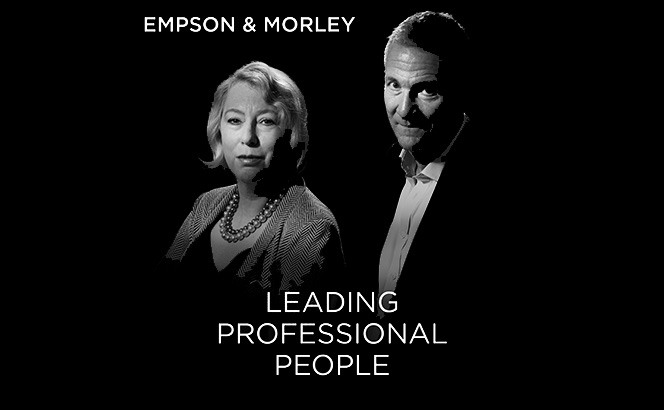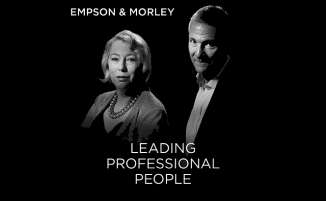Professor Laura Empson and David Morley ask what makes partnerships so distinct from corporations in what they demand of the people who lead them
Immerse yourself in a strong and successful professional partnership, even for a short time, and it becomes clear that these are unique entities requiring a very distinct kind of leadership.
Strong partnerships can – and often do – inspire an extraordinary sense of attachment and commitment for those already elevated to partner and those earlier in their careers who aspire to become partner one day.
These qualities set partnerships apart from more conventional corporate structures.
Of course, many people are deeply committed to their work in corporates. And there are corporates – for example some family-owned companies – that may inspire the level of loyalty, cohesion and belonging found in partnerships. But it is the depth and breadth of the commitment found in partnerships that tends to set them apart.
So what demands are made of the leaders tasked with protecting, nurturing, and even growing partnerships?
On the surface, there are some clear distinctions. In partnerships, owners’ and producers’ economic interests tend to be closely aligned – partners, of course, wear both hats.
In the corporate world, leaders are answerable first and foremost to shareholders, and the interests of the management and investors can be quite divergent. Partnership circumvents the principal-agent problem.
There are other powerful forces at play, for example, identity. Although partners may have a high degree of autonomy – to manage their practice and their clients – many have an equal desire to be part of a collective endeavour, with other high-performing peers, bigger than them as individuals.
These bonds are real. People tend to know each other well, at least within the same office or practice, having grown up together through the ranks. They understand each other’s strengths and weaknesses and want to see their fellow partners succeed.
It’s not just about mere legal form, either. There are some corporations – McKinsey is one example – that choose to mimic the best qualities of partnerships, often successfully. And when you analyse what they are trying to copy, it boils down to three main factors.
First, it’s about how you hire and socialise people into the firm’s culture. That could be a young lawyer, straight out of university who you want to develop into a top professional and, hopefully, see through to a partner role.
Or it might, more problematically, be a lateral hire. The best firms spend a great deal of time and money making sure they hire the right person, someone who gets the culture and is accepted within it – and integrating them to avoid the danger of so-called ‘organ rejection’.
Secondly, it’s about how senior professionals are managed, inspired, rewarded and sanctioned within formal and informal power structures, the latter often being more important than the former. For instance, peer pressure within a partnership is a powerful force of influence, usually as intense as the direct, top-down authority.
Finally, it’s about governance. Do you elect your leaders? How do your leaders engage and provide oversight? Where do they look for challenge?
One man who has a unique perspective on leadership challenges in both a partnership and corporate context is Sir Ian Davis, former global managing partner of McKinsey and now a non-executive on many blue-chip company boards, including Rolls-Royce, where he is chairman.
In the latest episode of our Leading Professional People podcast, Sir Ian joined us to identify leadership in these two very different environments. He quickly identified a series of subtle balancing acts that a partnership leader needs to master.
Corporate leaders tend to exercise power in a more directive way, while partnerships call for a more consensual style. Use power too directly in a partnership, and the chances are you will fail. Fellow partners just don’t accept power exercised in this way.
In that sense, the position of leader in a partnership can resemble a corporate non-executive chair, who may have plenty of authority and influence, but little or no formal executive power.
Leadership is always contextual, and the trick is to choose the style of leadership that best fits the specific circumstances.
Again, it’s about balance. For instance, there’s a delicate balance to be struck in a professional firm between autonomy – something partners demand and expect – and anarchy.
And there will be times when, to preserve and develop the collective identity and social adhesion that are the hallmarks of a strong partnership, it may be necessary to tolerate a level of individual underperformance – although only for a short time.
Since professional firms rarely have non-executives to challenge the leadership, leaders need to look elsewhere for push back. Clients can be a potent source of challenge, and it is important for leaders to gather direct client feedback rather than have it filtered through fellow partners. However, as the recent spate of professional misconduct scandals has demonstrated, the desire to satisfy the client can also lead professionals into murky ethical waters.
Younger people in the firm are an equally important source of challenge. For instance, giving them a role in strategic initiatives promotes innovation and diverse views. It also sends an important signal that they have a vital role to play in shaping the firm’s destiny and preserving its culture.
Growth can provide a particular conundrum for partnerships. It is quite common to find a group of partners who worry that growing too far and too fast will ultimately destroy the partnership’s unique culture. There can be a sharp divide between partners who take a reductionist view of growth and expansionists.
There are, of course, huge dangers in pursuing growth for the wrong reasons. Expand just because your competitors are doing so, rather than for strategically sound reasoning, and you can end up driving the firm into a brick wall – or worse still, into a lawsuit.
But growth and momentum in a partnership are critical to sustaining morale and creating space for the next generation of partners coming through.
That means finding a way to grow that preserves and enriches the partnership, rather than putting it at risk. And this is perhaps the area where it is most difficult for the leader to strike the right balance.
So growth, as with everything else, must be managed with a sense of guardianship – guided by a determination to leave the partnership in better shape than you found it.
Click here to listen to their latest podcast, “Empson & Morley – Leading Professional People”, where Professor Laura Empson and David Morley discuss the challenges of leading a partnership with Sir Ian Davis.











